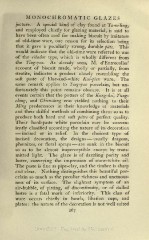Page 329 - Oriental Series Japan and China, Brinkly
P. 329
MONOCHROMATIC GLAZES
Ajecture. special kind of clay found at Ta-u-ling,
and employed chiefly for glazing material, is said to
have been often used for making biscuit by imitators
of old-time ware, one reason for its selection being
that it gave a peculiarly strong, durable pate. This
would indicate that the old-time ware referred to was
of the celadon type, which is wholly different from
the Ting-yao. As already seen, M. d'Entrecolles'
account of biscuit made, wholly or partially, from
steatite, indicates a product closely resembling the
soft paste of blue-and-white Kai-pien ware. The
same remark applies to Ting-yao porcelain, but un-
fortunately this point remains obscure. It is at all
events certain that the potters of the Kang-hsi, Tung-
ching, and Chien-lung eras yielded nothing to their
Ming predecessors in their knowledge of materials
and their skilful methods of combining them so as to
produce both hard and soft pates of perfect quality.
Their hard-paste white porcelain may be conven-
iently classified according the nature of its decoration
incised or in relief. In the choicest type of
incised decoration, the designs usually dragons,
phoenixes, or floral sprays are sunk in the biscuit
so as to be almost imperceptible except by trans-
mitted light. The glaze is of dazzling purity and
lustre, conveying the impression of snow-white oil.
The paste is fine as pipe-clay, and the timbre is sharp
and clear. Nothing distinguishes this beautiful por-
celain so much as the peculiar richness and unctuous-
ness of its surface. The slightest symptom of an
air-bubble, of pitting, of discontinuity, or of dulled
lustre is a fatal mark of inferiority. This class of
ware occurs chiefly in bowls, libation cups, and
plates : the nature of the decoration is not well suited
267

